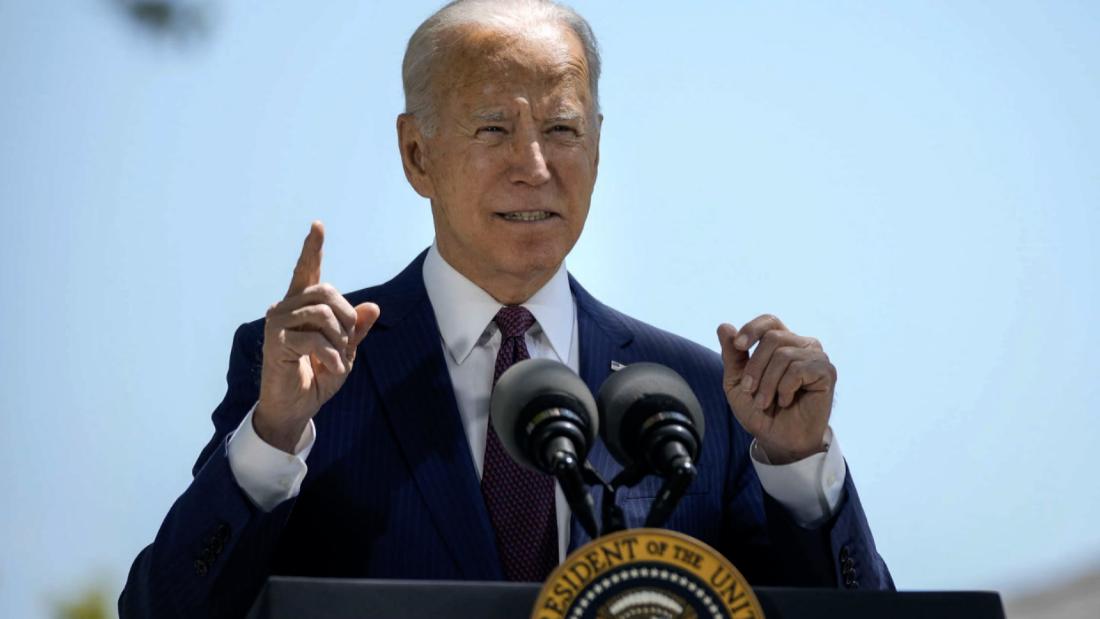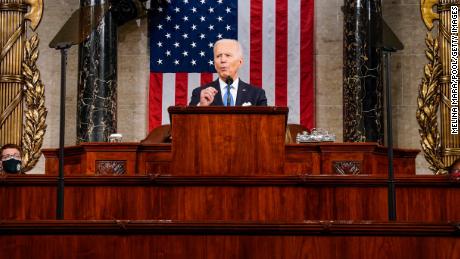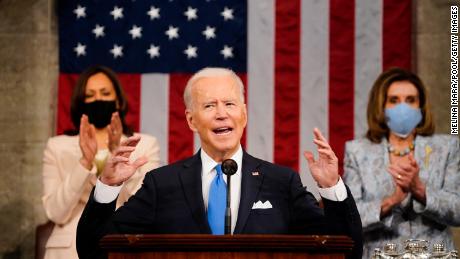Analysis: A Biden boom may be about to reshape America’s politics
Yet, from Joe Biden’s point of view, the signs of a long-awaited rebound actually make his core goal — sharing prosperity with working Americans and not just the wealthy — even more urgent and on point.
Voters are paying attention and that’s the reason the White House sees an opening amid the crisis for a transformational moment.
“What did you do? What would you do with your vote here in Georgia? … You began to change America and you’re helping us prove that democracy — democracy can still deliver for the people,” the President said.
“But as much as we’ve done, we’ve got a lot more to do,” he said, turning to the infrastructure plan that he is trying to push through Congress. “It’s a once-in-a-generation investment in America. It’s the biggest jobs plan in this country since World War Two.”
Fulfilling a campaign promise
Biden has presented his American Jobs Plan as a fulfillment of his campaign promises to reward the middle class and union households, and on Thursday he argued that it would also deliver “real equity across the board to everyone: Black, White, Latino, Asian-American — good jobs, good schools, affordable housing, clean air, clean water.” On Wednesday night, in his first address to a joint session of Congress, he outlined the second part of his infrastructure proposal — a large-scale investment in education, child care and paid family leave.
That framing of the President’s ambitious economic plans is not just central to the President’s lifelong philosophy. It is also critical to addressing the most important political challenge he faces — a need to lure moderate voters, especially in the industrial Midwest, who have been alienated by the Democratic Party’s drift to the left and ultimately aligned with Trump on cultural issues.
The medium-term political question is whether the benefits of a fast-expanding economy could sway some GOP and independent voters to Biden’s side who opted in two elections for Trump-style populism. Such Americans bought into Trump’s scorching messages on immigration, guns and now back his claims the last election was stolen and that Democrats want to defund and eradicate police forces.
Republicans are already making the calls by some Democratic activists to “defund the police” their attack against moderate Democratic lawmakers, and that GOP talking point became one of the most effective attack lines against congressional Democrats during the 2020 elections.
The size of Biden’s economic proposals has also given Republicans more fodder for their argument that Biden has lived up to the GOP’s claims that he’s a radical pushing “socialist policies” that are out of step with most Americans.
It’s a familiar Republican line — and it worked in President Barack Obama’s first term when conservative alarm about big spending nurtured the Tea Party movement that helped the GOP win back control of Congress. Yet it is still to be proven whether similar attacks work now, since Trump had no problem exploding deficits and there was less resistance within his base to government action that helps the working class when he proposed it.
A crucial test for 2022
Looking ahead to this first midterm election cycle of a new presidency — when the party in power in the White House traditionally loses seats — Biden’s appeals will test whether the potential rise in economic prosperity fueled by historic government intervention will have as much power to persuade swing voters as the cultural appeals of Trump’s GOP.
“There’s a big meta question — to what extent do economic gains actually filter into political behavior. That is the riddle,” said Mark Muro, a senior fellow at the Brookings Institution who closely studies the way economic disruptions have affected the American workforce. But he noted that Biden’s plans are “huge programs that are going to make a difference rapidly, so you’re really going to see an attributable benefit from them.”
He added that Biden’s Covid relief plan also has large amounts of “very flexible, easily used state and local aid” that may help many of the communities that are struggling economically, including in the Midwest where Trump and Biden battled for voters. That aid may have not only forestalled layoffs that would have occurred because of the pandemic; it may also help small towns and rural areas create new initiatives like job training programs or educational grants for workers. If the Biden administration is effective in branding those programs as a result of their work, some persuadable voters may take notice.
The state and local aid, Muro said, is “undersold as an important part of this — and it will be some of the fastest (aid) to hit the streets.”
Ultimately, improving the lot of working and middle class Americans and creating broader prosperity is fundamental to a mission Biden defined this week to mend frayed US societal cohesion — and democracy itself to keep up with rising economic superpowers like China, which see the US in inexorable decline.
A strengthening economy
Signs of economic awakening are everywhere.
The Covid-19 vaccine rollout’s success, with tens of millions of people already or shortly to be fully vaccinated, has hospitality and travel industries on a hiring spree and consumer spending soaring as long-lost freedoms beckon.
Given the normal laws of politics, such data might offer the President a political boost and validate the promise that got him hired — to end the worst public health crisis in 100 years and get the country back to work. Presidents often get too much credit and too much blame for short-term booms and busts in the economy, but their policies in the long term can set the foundation for prosperity for millions of people.
At a deeper level, a fast rebound could change the forces and calculations that will dictate the fate of the most audacious effort by a Democratic President to transform the US economy and social safety net in generations.
With Republicans and some moderate Democrats — including Senate swing vote Joe Manchin of West Virginia — leery about Biden’s multi-trillion dollar plans, a strong economy could undermine the case for more spending.
On the other hand, rising stock markets and a flurry of balance sheets showing bumper profits could strengthen the President’s case that the very richest Americans and corporations can afford to pay higher taxes to fund his plans.
Biden argued in his speech Wednesday night that the pandemic had widened inequalities that were further stretched by Trump’s massive corporate and personal tax plan that helped the rich.
He has already signed into law a $1.9 trillion Covid relief plan that injected billions of dollars, in the form of $1,400 stimulus checks for many Americans into the economy. His more than $2 trillion infrastructure plan is about far more than roads and bridges. It expands into non-traditional areas like home health care for the elderly, which activists say is critical to improving the economy and lives at a grassroots level. Biden’s $1.8 trillion dollar American Families plan targets education and child care, an industry that suffered serious economic blows in the pandemic.
“I invited her to come with anyone she wants to bring with her to the White House,” Biden told reporters. “She seemed very positive about wanting to do something, and I’m interested to hear what they have to say.”
Capito tweeted that she had a “constructive & substantive call” with Biden about infrastructure: “We both expressed our mutual desire to work together & deliver results for the American people,” she said. “I stand ready to be a partner in advancing bipartisan infrastructure legislation—just as we’ve done in the past.”
The willingness of Republicans like Capito to engage with the Democratic President suggests that the GOP sees the potential allure of his proposals to voters.
![]()






